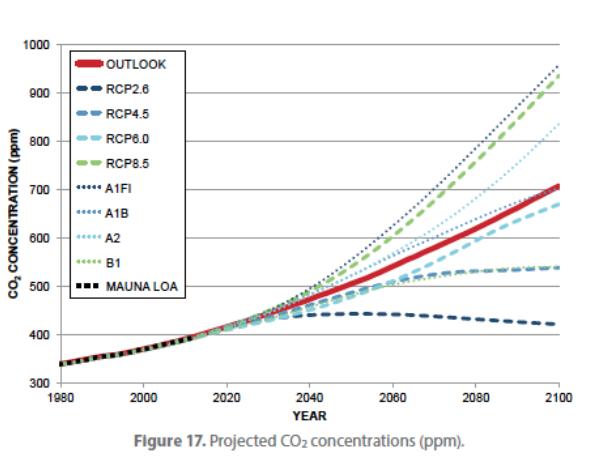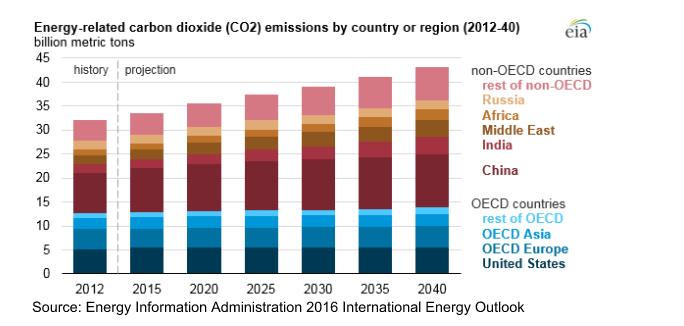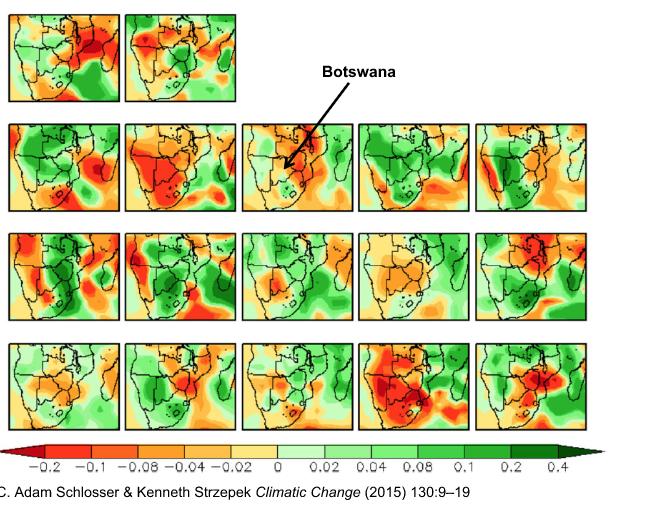Several weeks ago I attended a workshop put on by MIT climate researchers that dealt with current uncertainties in climate science and useful directions for climate research. I have worked with the folks at MIT since I was in graduate school, and specifically on the science and economics of climate change for just about 30 years. As usual, talking to them at this workshop suggested some new ideas that I wanted to share.
The general sentiment on climate policy among these researchers was that the best we can expect is a modest slowing of the rate of temperature increase. Recent work from MIT also reveals that forecasts of the possible impacts of climate change still differ dramatically. Combining these two insights reveals a large gap in our current understanding – we do not have a good handle on who is most likely to be affected, where and how, under realistic scenarios for temperature increase. The immense popular and scientific literature on the effects of climate change has generally assumed no action to reduce emissions and no smart adaptation to avoid damages. So the stories of melting icecaps, retreating shorelines, epidemics of tropical disease, heat waves, droughts and floods are largely intended to communicate what might happen if we do nothing.
At the other end of the scale, immense effort has gone into figuring out what it would take to keep global average temperatures from rising by more that 1.5 to 2ºC, levels that some believe would avoid all “dangerous human interference with the climate.”
Once we recognize that the best outcome of global action to reduce emissions is likely to be significant temperature increase and a good bit of damage, the uselessness of studies of no action and ideal action becomes clear. What we need to understand are the risks posed by temperature increases of more than 2 degrees at a temporal and geographic scale that is useful for planning. In addition to work done at places like MIT, reports of a United Nations organization known as the Intergovernmental Panel on Climate Change are useful references. The IPCC utilizes climate experts from around the world to write their reports, and I was a principal lead author of the second of their big reports on climate science and policy
The first step toward understanding our knowledge of climate risks is to realize how uncertain current forecasts of temperature increase and impacts really are. To make such a forecast there are several steps:
Predict future economic growth and technological breakthroughs in order to forecast greenhouse gas emissions
Compute how much temperature will increase based on predicted greenhouse gas emissions
Predict changes in precipitation (rainfall) and other geophysical and weather-related impacts
Assess how those changes will affect human populations
A forecast of total global emissions is sufficient to drive forecasts of temperature increase, since the major greenhouse gases have the same effects on temperature no matter where they are emitted (black carbon is different, but that is another story). But different models give very different results for temperature even when they assume the same increase in emissions. As a result, the lPCC has concluded that if the volume of greenhouse gases in the atmosphere reaches twice the level observed from 1850-1900, that will cause global average temperature to rise by between 1.5 and 4.5 degrees C above what it was back then. And the IPCC states that it cannot say whether the high, low or middle of that range is more likely (https://www.ipcc.ch/pdf/assessment-report/ar5/wg1/WG1AR5_TS_FINAL.pdf)
Since the pre-industrial level is estimated to be 275 parts per million (ppm) of CO2 in the atmosphere, doubling is conventionally set at 550 parts per million. Depending on the emissions forecast, we could reach that point between 2050 and 2075 or even later. And somewhere between those dates, temperature increase would be between 2 and 5ºC. The picture below may help clarify this. It is from MIT’s 2015 Global Energy and Climate Outlook, and it shows predictions of greenhouse gas concentrations from a number of sources. According to the MIT Outlook, we would hit 550 ppm around 2065, and at that point temperature increase could be 1.5 to 4.5ºC above pre-industrial levels. According to more pessimistic forecasts, we could hit 550 ppm and expect 1.5 to 4.5ºC increases as early as 2050. Forecasts that hit 550 ppm much later than 2075 assume very strong measures to reduce emissions in every country and are not very likely.

Although only total emissions matter for temperature, where they are generated matters for thinking about reducing emissions. That is where pessimism about avoiding climate change comes from. The chart below breaks a middle of the road forecast of emissions out across countries, based on their plans in accord with the Paris agreement.

Source: Energy Information Administration 2016 International Energy Outlook
Even if we do not make any additional efforts, emissions from the OECD countries (USA, Canada, UK, Europe, Japan, Korea, Australia, NZ etc.) will in total be stable or decline due to slow population growth and technological progress. China will be by far the largest single source, eventually surpassing all of us, and total emissions from India, the Middle East and Russia will be right behind. By just 2040, the OECD will decline to 32% of global emissions, and will continue to shrink.
Thus far the only countries that have made commitments to reduce their emissions in the next decade are in the OECD. All of the rest of the world puts economic growth and strategic advantage ahead of climate in their national priorities. Even if they adhered to the Paris Agreements now under review by the Administration, China would remain on this path until at least 2030 and then consider slowing the growth in its emissions. India made no quantified commitment, nor did most of the rest of the non-OECD countries, which see no way to rise out of poverty without increasing emissions.
Putting this political realism together with the uncertainty of temperature response, we should be planning for more than 2ºC and possibly up to 5ºC temperature increase in the next century. To do this in a systematic way, and to address the greatest risks first, we need to assign probabilities to the effects of temperature increases on a geographic scale that distinguishes places where there will be large and harmful changes from places where there will be lesser impacts.
That gets us to steps 3 and 4, where things get really hard. One thing that all models agree on is that temperature change will not be uniform around the globe. Therefore temperature forecasts need to be specific to different locations. Unfortunately, the models differ widely on what will happen at any particular location. Models generally agree that the greatest temperature increases will be in polar regions, but that the largest changes in precipitation and water availability will be in the tropics and further south. Unfortunately, they do not agree on the critical details of where within the equatorial regions those changes will occur.
The pictures below show predictions of changes in rainfall for Southern Africa from 17 different models, stated for comparability as the change in rainfall for a 1ºC increase in global average temperature. Forecasts need to be at this finer scale because effects of temperature on precipitation are even more localized than temperature changes themselves. So picking Botswana, we see that colors range from bright red to bright green, indicating that rainfall could either decrease (red) or increase (green) dramatically. Not much use for planning water supply or flood protection or public health or where and what kind of crops to plant in the nation of Botswana, let alone in the Kalihari or the Okavanga Delta.
Source: “Regional climate change of the greater Zambezi River Basin: a hybrid assessment”

- Adam Schlosser & Kenneth Strzepek Climatic Change (2015) 130:9–19
Effects on the people who live in these places and their opportunity to make a living come next will differ, depending on which of these contrary forecasts come to be. And those human impacts will depend on how capable the affected people and societies are of innovating and adapting to change, and on how their governments invest in and encourage actions in advance to reduce harm.
I take three important lessons from this. First, potential future effects of climate change on people are much more uncertain than forecasts of future emissions and temperatures. Impacts in the latter half of this century could be quite tolerable, if the 1.5ºC forecast is correct, because that is the temperature increase at which the IPCC foresees few harmful effects. What the consequences of temperatures higher in the range might be is subject to all the remaining uncertainties about geophysical and human effects.
Second, even though we can recognize the uncertainty, we cannot quantify the risks that different populations face. That is, no one has connected the results of a full-sized general circulation model on the distribution of temperature to a disaggregated model of weather and geophysical effects in a way that would let us attach probabilities to the human impacts of climate change. The study that produced the analysis of the Zambezi basin takes this calculation as far as rainfall, but only incorporates the variations across models of rainfall. It does not bring in uncertainty of emissions, temperature increase or consequences of changes in rainfall for agriculture, disease, etc. This is an active field of research, but not an easy one and one that should get high priority in funding climate research. Without it, all we get are basically scientific anecdotes of what might happen, with no idea of how likely those events are or where it would be most cost-effective to prepare for them.
Third, none of this implies that the US and the rest of the OECD should do nothing to reduce their emissions, but what we do should be flexible and realistic. It is not in our power to reduce emissions enough to prevent potentially dangerous climate change, nor can we compute the odds on how much damage our policies would avoid. Even if we were able to forecast what policies would accomplish in reducing emissions, there is still that 1.5 to 5 range of possible temperature change and the huge disagreement about the regional effects of temperature change on weather and other impacts. This convinces me that insistence on setting targets for reducing emissions in order to have certainty about emission reductions is badly misinformed. We can, on the other hand, have confidence that a carbon tax set at a tolerable level will make a difference in emissions and will reduce the likelihood of the worst possible outcomes. That modest step seems to me to be one we should all be able to agree on, while concentrating on developing science and policies that could contribute to helping the most vulnerable areas and peoples to adapt to what is coming despite our best efforts.
David Montgomery was formerly Senior Vice President of NERA Economic Consulting. He also served as assistant director of the US Congressional Budget Office and deputy assistant secretary for policy in the US Department of Energy. He taught economics at the California Institute of Technology and Stanford University and was a senior fellow at Resources for the Future.



Liz Freedlander says
I would add another conclusion -heavily invest in the very best scientific research on climate change to narrow the unknowns.
David Montgomery says
I would like to agree, not least because I have so many friends and former colleagues who would benefit. Yet it seems to me that what the best scientific research has revealed so far is how uncertain the effects of climate change remain.